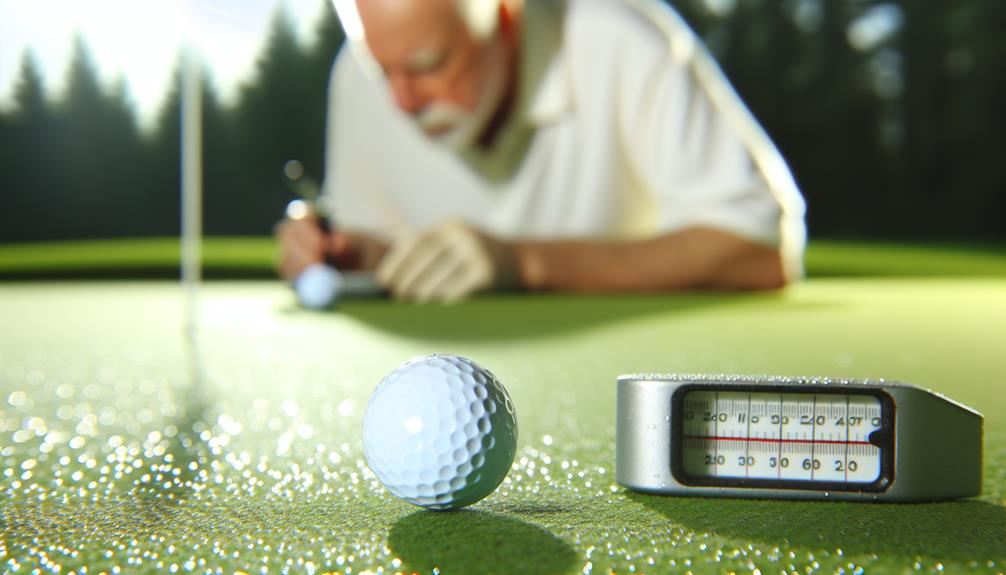Imagine you're on the 18th hole of the Augusta National Golf Course, a crucial putt stands between you and the coveted green jacket. You study the putt from all angles, but the one thing that's eluding you is the speed of the green.
This isn't just about how hard to hit the ball, it's about understanding the subtle nuances of the green's speed, which can make or break your game. As you assess the putt, you realize the importance of decoding the green speed.
How can a golfer, like you, dissect this critical aspect of the game to improve performance? Let's unravel this mystery together.
Understanding Putting Green Speed
To truly master your golf game, it's crucial to understand the concept of putting green speed. This refers to the velocity a golf ball requires to roll over a specific distance on the green. It's not just about how hard you hit the ball; it also involves understanding the green's texture and adapting your stroke techniques accordingly.
A course's green texture can significantly influence ball speed. It's not a one-size-fits-all scenario. For instance, a smooth, dry green will allow a ball to roll faster and further compared to a wet, rough green. Therefore, it's essential to examine the green's texture before you take your shot.
Your stroke techniques come next. You need to adjust your stroke power based on the green's texture and the distance to the hole. A gentle stroke may suffice on a fast, downhill green, while a stronger stroke might be necessary on a slow, uphill green. Remember, the objective is to get the ball to the hole, not beyond it.
Measuring Speed on Putting Greens
Having grasped the effect of the green's texture and your stroke on the ball's speed, it's crucial you understand how to measure this speed on putting greens.
A valuable tool at your disposal is the Stimp meter. This device allows you to determine the green's speed by measuring the distance a ball rolls on a flat surface. You release a ball from a notch in the meter down a ramp, and the distance the ball travels in feet indicates the green's speed. It's that simple.
Additionally, ball trajectory analysis provides insights into the speed at which the ball travels on the green. By observing the path and speed of the ball, you can discern the impact of the green's texture on the ball's trajectory and adjust your stroke accordingly.
Factors Influencing Green Speed
Several factors can significantly influence the speed of putting greens, and it's essential you're aware of them to optimize your golf game.
The first factor is the type of grass used. Different grass types exhibit varying characteristics, affecting the ball's roll speed. For instance, Bentgrass is often used for its fine texture and high density, providing a fast, smooth surface. Conversely, Bermuda grass, being coarser, tends to offer a slower roll.
The weather impact is another crucial factor. The effect of weather on green speed isn't to be underestimated. Higher temperatures can cause the grass to grow faster, which naturally slows down the ball's roll. On the other hand, dry conditions can harden the soil, leading to faster green speeds. Rain, too, can significantly slow down the greens by making the surface wet and soft.
Other factors like green maintenance practices and the green's design and slope can also play a role. Regular mowing, rolling, and watering can alter the green's speed, while the slope can change the ball's path and speed.
Understanding these factors will help you adjust your golf strategy accordingly.
Managing Speed for Better Performance
Now that you're aware of the factors influencing green speed, let's explore how you can manage this speed for better golfing performance. Speed control techniques and performance optimization play a vital role in this process.
Firstly, understanding and adapting to the conditions of the course is crucial. This involves assessing the moisture, grass type, and even the time of day. For example, early morning greens may be slower due to dew. You'll need to adjust your putting speed accordingly.
Secondly, practice is key. Spend time on the greens, getting a feel for the speed. Try different putts at varying speeds and observe the outcomes. This hands-on experience is invaluable in improving your speed control.
Additionally, consider the use of technology. Modern golf gadgets, like stimpmeters, can provide accurate measurements of green speed, aiding your performance optimization.
Lastly, don't underestimate the importance of mental preparation. A calm and focused mind improves your ability to judge and control the speed.
Role of Green Speed in Golf Strategy
Understanding the role of green speed in your golf strategy can significantly enhance your game, allowing you to make informed decisions about your shots and overall approach to the course. It's not just about how fast or slow the ball rolls, but how you adapt your technique according to the green's speed.
Speed Adaptation Techniques are crucial. For instance, on faster greens, you may need to adjust your backswing to be less forceful, maintaining control of the ball's movement. Alternatively, on slower greens, a more assertive swing may be necessary to cover the distance.
But remember, it's not just about adjusting your swing. The speed of the green can impact the ball's trajectory and break, factors you must consider in your planning. That's where Speed Impact Analysis comes in. This involves studying how green speed affects the ball's path and adjusting your aim accordingly.
In essence, a successful golf strategy isn't just about power or precision, it's about adaptability. By understanding and incorporating the role of green speed into your game, you're not just reacting to the course's conditions, you're using them to your advantage.

